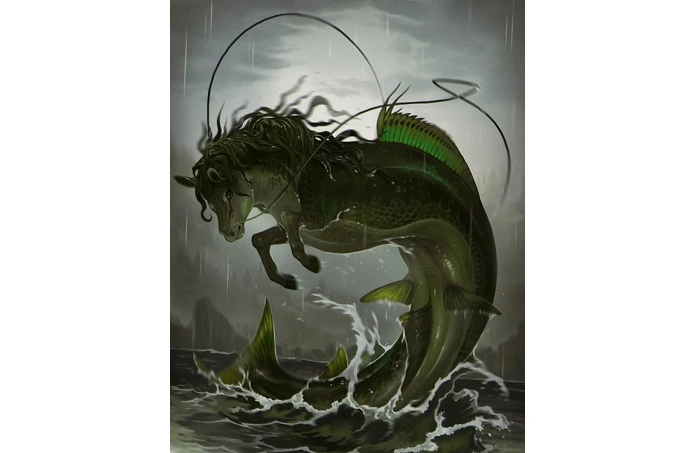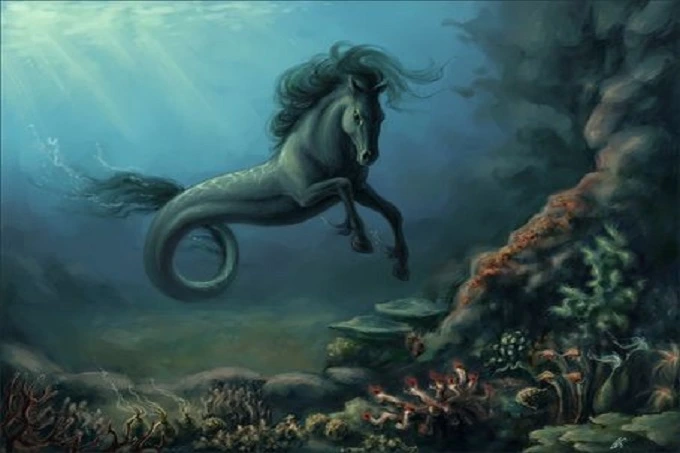Kelpies: strange monsters from the mythology of the British Isles

We are speaking about a creature known as a water horse, a monster that does not exist on the mainland but is quite common on the islands. The monster’s name speaks for itself: kelpie. What is it that makes kelpies so strange? The fact that this monster does not correspond to any of the accepted canons inside conventional mythology.
A unique name referred to the water horse in each area, but its characteristics were generally the same. The monster lived under the water, and when it emerged onto land, it assumed the form of a horse. These two primary characteristics always corresponded with one another. It is common knowledge now that the horse form of a werewolf is a sleek and exquisitely attractive animal, yet in the past, no one had any idea what this meant. In certain traditions, the term “horse” may also refer to a pony or a colt. It should come as no surprise that smaller kelpies outnumbered their larger counterparts.
In addition to the shape of a horse, werewolves often had one or more “alternative forms.” It could assume the shape of a calf or a lamb. And the most developed individuals even started to expand into humans. In young males as a general rule, but sometimes in females as well. Some inexperienced kelpies might sometimes emerge in the “intermediate” form of an upright horse if they had not yet mastered the art of reincarnation. This was probably the reason for this.

Although the monster’s choice of disguises may seem peculiar at first glance, its strategies in its quest make them quite reasonable. Kelpie actively sought to be captured. As soon as the victim rode the water horse, the unfortunate rider became firmly wedged, and the water horse took him down the abyss. Where it gobbled everything up on an odd whim, leaving the corpse with nothing except the liver and lungs. Strangely, the kelpie couldn’t hold a person for a significant amount of time; as a result, it had to work like a horse for a considerable amount of time before the water came within throwing distance.
Kelpie was seen both during the day and throughout the night. A werewolf might potentially call any location home, including the ocean, a lake, a river, or even the mill dam. If huge flocks or herds came from the bays, then the only thing that could have been hiding in the little reservoirs and river whirlpools was a single person. However, they also presented a very real risk. It’s been documented that a water horse once kidnapped and consumed all seven of its human victims at once. Even if the monster avoided humans entirely, it nevertheless slaughtered sheep and cattle, leaving farmers in financial disaster.
On the other hand, not every kelpie was a vicious monster. Many of the people that belong to this tribe have the reputation of being mischievous animals. “Peaceful” water horses even dragged the victim into the river before letting the rider go, leaving the rider completely drenched, disheartened, but otherwise unhurt. In addition to that, they had many additional cruel but “non-lethal” jokes in their arsenal. After all, the mischievous kelpies understood a lot more about the process of reincarnation than their violent ancestors did. Some of the goblin pranksters (and in Britain, any supernatural creature was referred to as a “goblin” or a “fairy”) did not have to pretend to be not just one person but several persons at the same time.
According to the old tales that have been passed down, kelpies that were separated from big amounts of water became, for the most part, mischievous but harmless creatures. And there is a certain kind of reasoning to this. Sitting in a shallow pool poses a significant risk when on the lookout for people. In fact, the peasants successfully carried out their intentions because they had decided to lay in wait and kill the monster.

Iron, which was widely available throughout the Middle Ages and was thought of as an “anti-magic” metal, proved to be an effective weapon against kelpies. Unexpectedly, a werewolf who had taken the appearance of a horse was found to be rather ineffective in battle. When he was immersed in water, he was capable of completely decapitating a man.
The abnormalities that do not belong in the canon mark the beginning of the most interesting part of the story. Every werewolf maintains at least one true form. However, the kelpie was a remarkable exception. No one has ever seen a water horse in its natural habitat; thus, nobody knows what it looks like. Every day, a “continental” shapeshifter always takes human form. This is a sorcerer who can transfigure into a beast (the version of the “disease” or “curse of lycanthropy” arose only in modern times). But the kelpie does not belong to the human race and rarely knows how to copy a person’s appearance, and even less often does it convincingly, not forgetting to hide horse ears and hooves. On the other hand, he is not a horse either. What kind of “werewolf” is this without a true guise?
A body of evidence lends credence to the idea that the kelpie does not resemble anything. That it is a disembodied soul of rivers and oceans who had no choice but to construct a body out of improvised materials and give it the appearance of being accomplished by using illusions. After all, if a water horse could be killed on land, its body would deteriorate into a swarm of jellyfish or decaying algae.
Because of England and Ireland’s climate, water horse stories are common. On the islands’ seacoast, hoof tracks going into the sea were left by a herd of regular, non-magical horses skirting the coastal cliffs or traversing the bay along the exposed bottom at low tide. But, like contemporary people, the ancient Celts saw mystery or “conspiracy” in the most mundane events.




